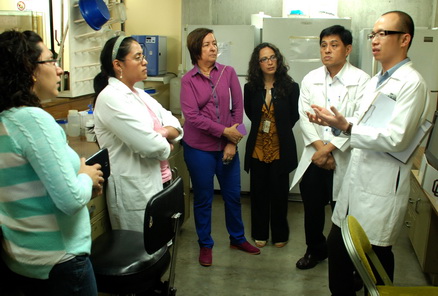
TaiwanICDF Assists Guatemala in Establishing HLB Detection Center as Taiwanese Experience Raises Central American Partners’ Capacity to Fight Spread of HLB
With the Dominican Republic, Belize, Honduras, Guatemala, Nicaragua and other countries having been under attack from the citrus disease Huanglongbing (HLB) since 2008, the International Cooperation and Development Fund (TaiwanICDF) has been cooperating with the International Regional Organisation for Plant and Animal Health (OIRSA) to implement a Strengthening the Control of Huanglongbing (HLB) and the Implementation of Integrated Pest Management (IPM) in Citrus Project. The scope of implementation of the five-year initiative, which got under way in 2013, covers the Dominican Republic, Guatemala, Belize, El Salvador, Honduras, Nicaragua and Panama.
At the end of August 2014, the TaiwanICDF assisted the Guatemalan Ministry of Agriculture, Livestock and Food (MAGA) in establishing a regionwide HLB detection center. The hope is that the introduction of equipment and techniques from Taiwan will allow for the more precise and rapid detection and judgment of cases of HLB, thereby assisting in the control and prevention of the epidemic.
MAGA has paid considerable attention to the project, and has not only provided its “22 km Laboratory” to serve as the site of the center, but also sourced all of the instruments that the center has been equipped with from Taiwan.
In terms of technical skills, the TaiwanICDF has drafted in Dr. Hung Ting-hsuan, a professor from the Department of Plant Pathology and Microbiology at National Taiwan University, to introduce techniques from Taiwan. Specialist Taiwanese technicians have also been dispatched to assist in the training of local personnel working at the center in order to improve its soft components and hardware. In the future, samples from plants suspected of infection can be collected in the field and sent to the center for PCR (polymerase chain reaction) testing, where it should be possible to confirm the presence of HLB with a 100 percent rate of success.
Also known as citrus greening disease, HLB impedes the supply of nutrients to a plant, which causes leaves and stalks to wither and makes its roots decay, ultimately killing the whole plant. In the Dominican Republic, for example, since the presence of HLB was discovered in 2008 through to 2013, yields have declined by 60 percent, endangering the country’s citrus industry. If the disease continues to spread, it could cause production losses of as much as US$1 billion within the OIRSA’s jurisdiction, seriously affecting the region’s economy.
Through this project, the TaiwanICDF is passing on Taiwan’s experience, assisting partner countries in building the capacity to prevent and control HLB, and thereby safeguarding the continued development of the citrus industry. Overall, the content of the project involves assistance in building healthy seedlings systems, the implementation of comprehensive HLB prevention and control measures, the strengthening of disease detection technologies and the establishment of a monitoring and rapid response reporting system.
- Update: 2018/03/01
- Hits:325

